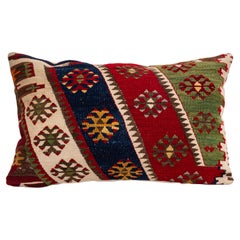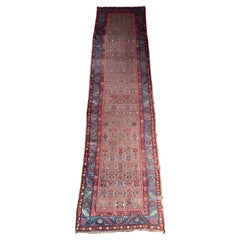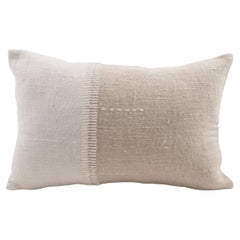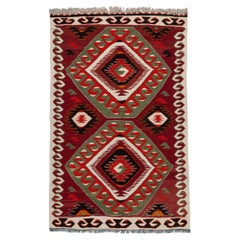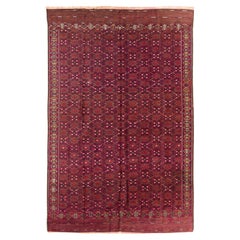Kilim Furniture
Known for their wealth of rich colors and unique weaving tradition, antique and vintage kilim rugs are one of the most distinguishable types of rugs. The term “kilim” is Turkish in origin, but many variations of this type of textile share a common heritage and are practiced all across the Balkans, throughout the Arab world and elsewhere. There are Persian kilim rugs, kilim rugs from Central Asia and more.
It is difficult to definitively pin down the origins of kilim weaving, which is known as a “flatweave” or “slit-weave,” but historians believe that skilled artisans may have practiced versions of it as early as the eighth and ninth centuries A.D. in the Anatolia region of Turkey. Many of the Turkish iterations of these flat-woven rugs are recognizable for their arrangements of dazzling, flowing forms, but a range of motifs can appear in kilim rugs — abstract figures that reference rams’ horns, snakes or running water or motifs that are intended to symbolize concepts such as the tree of life or fertility. In Anatolia, women have used kilims to share narratives about their lives.
The difference between a kilim rug and most other kinds of carpets or pile rugs is in the aforementioned weave. They are made by interweaving variously colored, individual strands of wool (pure soft cotton, silk and goat’s hair are also used with the wool, albeit rarely) versus, say, the Tabriz rugs of Iran, which are hand-knotted rugs. This results in a smooth, frequently reversible surface. It’s a slit-weave because of the gap left between two blocks of color. Kilims are created on a loom, a typically uncomplicated structure mostly made of wood. Owing to the creative freedom that a slit-weave can afford its weaver, they tend to feature a range of bright, contrasting hues like reds, oranges and pinks that appear in bold combinations with deep blues and greens that are brought to life with natural dyes.
Handwoven kilim rugs are less expensive to produce and more durable than other rugs. They were traditionally used as floor coverings in mosques and yurts, as prayer rugs and saddle coverings. And these textiles are pileless: Whereas the Beni Ourain rugs of Morocco can be described as dense with a thick surface or pile, an authentic kilim rug is thin and flat. Because the resulting weave is lightweight, kilim rugs are well adapted for use in the hot summer months, and they are happily embraced by tribal weavers of Morocco, a part of the world that is home to many styles of rugs.
With their striking geometric patterns and provocative color pairings, kilim rugs and wall tapestries are loved by design enthusiasts and can bring charm and interest into any dining room, living room or other interior space.
Find kilim rugs and textiles and other vintage rugs on 1stDibs.
Early 20th Century Turkish Kilim Furniture
Wool
2010s Turkish Kilim Furniture
Wool, Natural Fiber
Mid-20th Century Persian Kilim Furniture
Wool, Cotton
Late 20th Century Turkish Kilim Furniture
Hemp
Late 20th Century Turkish Kilim Furniture
Wool, Cotton, Natural Fiber
Mid-20th Century Turkish Kilim Furniture
Wool, Natural Fiber
2010s Turkish Kilim Furniture
Natural Fiber, Organic Material
2010s Turkish Kilim Furniture
Wool, Natural Fiber
2010s Turkish Kilim Furniture
Wool, Oak
2010s Turkish Kilim Furniture
Wool, Natural Fiber
Late 19th Century Turkish Antique Kilim Furniture
Wool, Natural Fiber
Mid-20th Century Turkish Kilim Furniture
Wool
Late 20th Century Turkish Kilim Furniture
Wool, Cotton, Natural Fiber
Mid-20th Century Turkish Kilim Furniture
Wool
Mid-20th Century American Kilim Furniture
Upholstery, Oak
2010s Turkish Kilim Furniture
Wool, Natural Fiber
1790s French Antique Kilim Furniture
Wool
Mid-20th Century Turkish Kilim Furniture
Wool
Mid-20th Century Turkish Kilim Furniture
Silk, Hemp
Mid-20th Century Turkish Kilim Furniture
Cotton
Early 1900s Ukrainian Antique Kilim Furniture
Wool
2010s Afghan Kilim Furniture
Wool
Mid-20th Century Turkish Kilim Furniture
Wool
Mid-20th Century Turkish Kilim Furniture
Wool
Mid-20th Century Mexican Kilim Furniture
Wool
2010s Indian Kilim Furniture
Cotton
20th Century Persian Kilim Furniture
Wool
1810s Persian Antique Kilim Furniture
Wool
Mid-20th Century Turkish Kilim Furniture
Wool, Natural Fiber
2010s Turkish Kilim Furniture
Wool, Oak
21st Century and Contemporary Turkish Kilim Furniture
Wool
2010s Pakistani Kilim Furniture
Wool
Late 20th Century Romanian Kilim Furniture
Wool
1950s Indian Vintage Kilim Furniture
Cotton
Late 20th Century Turkish Kilim Furniture
Wool, Natural Fiber
Early 20th Century Turkish Kilim Furniture
Wool
Early 20th Century Turkish Kilim Furniture
Wool
2010s Indian Kilim Furniture
Wool
Late 20th Century Persian Kilim Furniture
Wool
2010s Persian Kilim Furniture
Wool
Mid-20th Century Turkish Kilim Furniture
Silk, Hemp
2010s Turkish Kilim Furniture
Wool
20th Century Turkish Kilim Furniture
Cotton
1950s Indian Vintage Kilim Furniture
Wool
Mid-20th Century Turkish Kilim Furniture
Wool
2010s Turkish Kilim Furniture
Natural Fiber, Organic Material
Late 20th Century Turkish Kilim Furniture
Wool
2010s Indian Kilim Furniture
Cotton
Early 20th Century Uzbek Kilim Furniture
Silk, Natural Fiber, Organic Material
2010s Turkish Kilim Furniture
Wool
2010s Turkish Kilim Furniture
Natural Fiber, Organic Material
Late 20th Century Turkish Kilim Furniture
Wool, Cotton, Natural Fiber
2010s Turkish Kilim Furniture
Wool
Late 20th Century Turkish Kilim Furniture
Wool
2010s Turkish Kilim Furniture
Natural Fiber, Organic Material
Late 20th Century Moldovan Kilim Furniture
Wool, Natural Fiber
1980s Chinese Vintage Kilim Furniture
Wool
Early 20th Century Turkish Kilim Furniture
Wool
1940s Armenian Vintage Kilim Furniture
Wool, Cotton, Organic Material
Mid-20th Century Turkish Kilim Furniture
Wool
